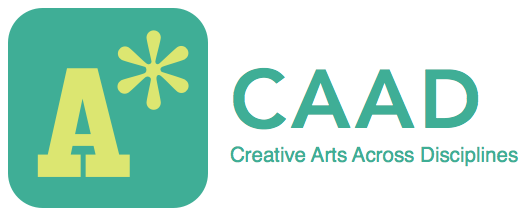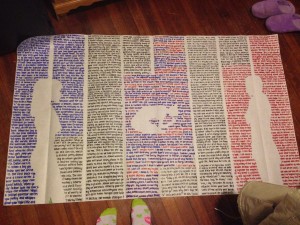When Ariel told us last fall about the Boundary-Crossing exhibit, I was excited. It sounded like an incredible opportunity to showcase the collaborative creative that CAAD is all about. Then when she mentioned that we would each contribute a mural to the exhibit, I panicked. The largest art project I’d done prior was a series of pinewood derby cars at a summer camp. And even then, I only made one per summer. As conventional as it was, a car covered in minions from Despicable Me took a long time to come up with. How long would it take to come up with an idea that would fill a 3′ x 5′ sheet of paper?
As I always do when I’m in doubt, I turned to the internet for help. For whatever reason, I fancied the idea of telling a story in silhouette. I happened upon Spineless Classics, a company that prints entire books on a single sheet. Thoroughly impressed, I decided to emulate this design. I knew I couldn’t pick images to draw until I determined what the text would be. Thus, I had a new problem. I initially considered using my own writing, but I hadn’t written anything long enough to cover the whole page. I thought of using the lyrics from a variety of songs. No that wouldn’t work, I decided, because songs are often much more powerful performed than merely read. I needed a short piece of work that was just as powerful read as it is performed. “And you wonder how it ever got to this…” The beginning of “Thank You” by Adam Falkner and Jeanann Verlee began to play in my head. As far as poets go, they’re two of my favorites. The medium was perfect, as it’s quite salient written and spoken. Thus, I knew what my text would be: slam poetry.
I guessed that about five complete pieces could fit on the page. A new issue arose. Much of slam poetry is extremely personal and often triggering. The most powerful ones are the ones, in my opinion, that hurt the most to hear, let alone to read. I knew I’d have to be careful about which ones I chose. I also wanted to make a point of including a variety of voices and stories — male, female, Black, White, love, race, etc. “Thank You” is about human connection.
These boots are for unlacing. These eyes are for sale. These legs are for flight. This mouth is a distraction. I mean, I miss your hands. Thank you. These tiny thieveries push into the gentle tug of a barber’s hands at your scalp, brush a cashier’s palm against yours, trace footsteps in a crowd, find the still-damp spots on subway handles. I’m sorry. Thank you.
I have to stop myself there or else I’ll just quote the whole poem. It’s passionate, powerful, and beautifully written. Adam and Jeanann are both White — male, female, White, love, connection. One poem down, four to go.
I spent hours watching video after video of slam poetry. I laughed, I cried, I reflected, I deflected. After much consideration, I’d picked four other poems. “Pretty” by Katie Makkai is about, as the title suggests, the word ‘pretty.’ Katie unpacks the simple, two-syllable word in unexpected, yet extremely relevant ways. Female, White, self-love. The third is “Cuz He’s Black” by Javon Johnson. Black, male, race. As a Black person, I knew I needed a Black voice on the mural. I desperately wanted to use T. Miller’s “Us – Black Women.” It’s one of the most powerful poems I’ve heard in a long time. As stated, though, the powerful ones are triggering. I knew I couldn’t write what she said. However, I did include “Unsolicited Advice to Adolescent Girls with Crooked Teeth and Pink Hair” by Jeanann Verlee, the first line of which is “When your mother hits you, do not strike back.” That’s overtly triggering and I still included it. Maybe the real reason I didn’t include T. Miller’s piece is because it’s too relevant, too painful for me to have written out. The Psychology major in me agrees. In light of recent events, though, Javon’s poem about police brutality toward Black men fit just as well.
Still, we both know it’s not about whether or not the shooter is racist. It’s about how poor Black boys are treated as problems well before we are treated as people. Black boys in this country cannot afford to play cops and robbers if we’re always considered the latter, don’t have the luxury of playing war if we’re already in one.
At this point, I decided to stop shying away from the poems that might hurt. They’re cathartic and beautiful; you get lost in the raw emotion of the performer as well as in your own. Thus, the last poem I chose is “My Father’s Family” by Adam Falkner. I treat is as a response to Javon’s poem, as Adam speaks to his history as a White male, what that meant for Black people, and why it hurts to have been “taught the right way” about it. Don’t worry, though, as “this is not about guilt.”
With the five poems chosen, I then had to organize them on the page. Since Jeanann and Adam are each represented twice, I put their joint poem “Thank You” in the center and flanked the sheet with their individual poems. “Pretty” and “Cuz He’s Black” would go in between. I had to be more specific than that, though. Since Adam speaks first in “Thank You,” I made Jeanann’s the first poem on the page (i.e. the one on far left). Thus, Adam’s was on the far right. I remembered then that I needed to put silhouettes on the page too. I found an image of a man and a woman standing back to back with their arms crossed. I decided to use it, putting Katie’s poem next to Jeanann’s and Javon’s next to Adam. Thus, the poems would read as follows: woman, woman, woman and man, man, man. The female silhouette would be on the left facing right, and the male silhouette would be on the right facing left.
Then, color presented a new issue. Although the Alice in Wonderland silhouetted story looked brilliant in all black, I didn’t want to be confined to the one color. Ariel presented me with black, red, blue, purple, and green sharpies. Since mixing red and blue makes purple, I used the purple sharpie to signify when Adam and Jeanann both spoke in “Thank You” and then either color for when they spoke alone. Since reds and pinks are associated with females and blues are associated with males, I flipped the convention. Jeanann’s words are in blue and Adam’s are in red. I knew I wanted Javon’s in black and for symmetry’s sake I wrote Katie’s in black as well. Thus, the poems read as follows: blue, black, blue/purple/red, black, red. So as not to leave it out, I signed my name with the green sharpie. Lastly, I figured I needed one more silhouette to round out the mural. I found one of a woman praying. Since this image would go in the middle of “Thank You,” I rationalized it because praying is like wishing or asking for something. When you ask for something, you say ‘please’ and “Thank You” ends with “please.” It’s a stretch, I know, but I really liked the silhouette. So, I used it. Thus, the planning was complete. Eight hours of nearly-continuous writing on the floor of my room in Joss later, I was done. And now, this piece that I made, that I essentially collaborated on with four of my favorite slam poets hangs in the Palmer gallery until this Friday March 13th. It would mean so much to me if you stopped by to see it. It hangs proudly next to the awesome work that Kayla, Alex, and Sofie did. So, be sure to check out their amazing work as well while you’re there!


